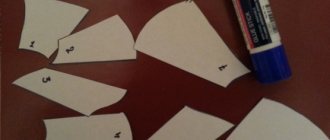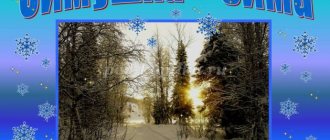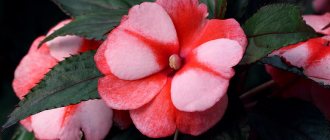Short-term project “Air around us”
Municipal budgetary preschool educational institution
Kindergarten “Zvezdochka” in the city of Zernograd
SHORT-TERM PROJECT IN THE PREPARATORY GROUP “POCHEMUCHKI”
"The Air Around Us"
Short-term project in the preparatory group “Pochemuchki” “The air around us”
Project type:
short-term, group.
Project type
: information and research, educational.
Project implementation timeline:
1 month
Project participants:
teachers, children, parents.
Children's age:
6 - 7 years old.
Relevance
Air is a magician who is capable of performing many miracles. It can lift a sunken ship from the seabed, make possible the smooth flight of an airship and the rapid movement of aircraft.
The preschooler has lived in the world for several years and is accustomed to encountering air everywhere. But a child is not yet able to learn on his own, to study its properties, to find out what he had not thought about before or had no idea about. Adults are accustomed to transmitting knowledge to children mainly through their eyes and ears. But if they passed through hands, through activity, then we could give every child joyful surprise, inquisitive analysis, the first inspiring success of a natural scientist. To develop the child's attention, thinking, speech. Our task is to awaken interest in the world around us, to develop the ability to make discoveries and get carried away. Currently, in connection with the revision of priority forms and methods of teaching in preschool education, it is precisely the methods that develop children’s abilities for initial forms of generalization, inference, and abstraction that predominate. And this method is experimentation.
The relevance of the chosen topic of the project is also in the fact that people do not take care of what they have, because every year more than a million tons of harmful substances are released into the air, which have a detrimental effect on the life of the entire living world.
Problem
Children do not have enough knowledge about air. People, animals and plants breathe air. Air is everywhere. How can you see it? How to prove that it exists? What is air? Why do people and other living organisms need it? What is the meaning of air? How does air get polluted? How to protect the air? Such questions arose from the children during a conversation about air.
Search for forms of answering the questions asked
1.Work with methodological and fiction literature.
2.Development of activity content and preparation of resources for conducting research, experiments, experiments with air, didactic games, and classes.
Objective of the project:
Create conditions for the development of children’s cognitive and research abilities during the project; to form in children knowledge about the importance of air in the life of all living things on earth.
Project objectives for children
- Introduce children to the concept of “air”.
- To form children's knowledge about the properties of air: transparent, invisible, can move, necessary for all living things to live.
- To develop cognitive interest in experimentation through involving them in conducting experiments.
- Replenish the children's vocabulary with the words: moves, inflated, deflated, invisible, transmits a smell.
- Develop a desire to find ways to solve a problem.
- Cultivate observation and curiosity.
Tasks for the teacher
1. Select and study methodological literature and Internet resources on the topic of the project.
2. Select didactic games, experiments, GCD notes and video materials about the properties and use of air.
3. Contribute to the consolidation of parent-child relationships and improve contact between preschool employees and parents.
4. Motivate parents to participate in the implementation of the project “Get acquainted - this is air!”
Tasks for parents:
1.Improve mutual understanding with your baby. Activate and enrich the educational skills of parents, confidence in their own pedagogical capabilities.
2. Stimulate children’s desire to learn new things about inanimate nature.
3. Provide an atmosphere of goodwill and comfort in child-parent communication.
Expected results:
- Increase the level of development of children's curiosity.
- Children should gain a basic understanding of air and its properties.
- Children should receive the simplest knowledge about experiments with which they can get acquainted with air.
- Development of children's communication skills and the ability to work in a team.
- Increasing the pedagogical literacy of parents. Involving parents in cooperation, acquiring knowledge on organizing educational and research activities on the topic “Air”.
Expected result
- Presentation of work experience in the form of a presentation.
- Organization of the photo exhibition “Air and Us”.
- Creation of the album “The Air Around Us”
- Organization of the group museum “Invisible Air”
- Video “Everyone needs air”
As a result of the project, children will know
- Where is the air?
- The role of air in human life.
- The role of air in the life of animals.
- The role of air in plant life.
- What is air needed for?
- Properties of air.
- Air purification methods.
- Rules for the young researcher.
As a result of the project, children will be able to
- Perform actions to organize experiments with air.
- Ask questions, look for answers.
- See a problem on a specific topic.
- Formulate a goal, plan tasks.
- Make hypotheses and test them.
- Select tools and materials for independent activities.
- Conduct feasible experiments and draw appropriate conclusions.
- Present the results of experiments in the form of simple diagrams, signs, drawings.
Main directions of work
- Work with children.
- Working with parents.
- Working with employees.
- Work to improve the subject-development environment.
Project implementation mechanism
- Work with children
planned and carried out throughout the day, through all activities.
- Classes of direct educational activities (DED)
- Experimental activities of preschool children.
- Search and research activities.
- Organization of games: didactic, board-printed, verbal, creative, role-playing.
- Organization of labor activities.
- Organization of artistic and speech activities.
- Organization of visual activities.
- Looking at paintings and illustrations.
- Organization of walks and observations.
- Reading works of fiction.
- Conversations.
- Exhibition of children's drawings.
Project Implementation Plan
- stage.
Preparatory
- Drawing up a project.
- Study and analysis of the level of development of cognitive abilities in children,
skills and abilities of research activities and creative
design.
- Selection of methods, forms of work with children, parents of pupils,
- Creating an effective subject-development environment in the group, creating an information space for parents.
- Selection of children's fiction to read to children.
- Work with methodological material and literature on this topic.
- Consultation for parents to familiarize themselves with the topic, objectives of the project, and content of the work.
- Selection of visual and didactic material, fiction on the topic of the project.
- Examination of illustrations, plot paintings.
- Learning games.
- Learning the musical repertoire.
- Use of information and communication technologies
Main stage
Planning work with children
| No. | The content of the work | Resource support |
| 1 | Conversations, didactic games | Conversations: “How to hear the air”, “Noses are needed not only for beauty”, “Flying seeds”. D/I: “What kind of wind”, “Guess what tree these seeds are from”, “What’s extra?”, “What’s first, what’s next?” Labor, involve the children in washing the leaves of indoor plants. |
| 2 | Reading fiction | S. Marshak “Soap Bubbles”, I. Tokmakova “Windy, Windy”, N. Nekrasov “Mourning Wind”, S. Mikhalkov “Three Winds”, S. Zhupanin “I’ll Draw the Wind”, Tale “Southern Wind” by V.M. Garshin; Fairy tale “Frog - Traveler” V. Kataev; Russian folk tale “Bubble, Bast Shot and Straw” Poems about air and wind ( Appendix 1) Riddles, proverbs and sayings about air. ( Annex 1) Conversations “What is air”, “The importance of air for the life and growth of living organisms”, “Noses are needed not only for beauty”, “What benefits does the wind bring?” ( Appendix 4) |
| 3 | Cognitive and research activities | Watching the wind. Air research in different places: in a room, on the territory of a kindergarten, closer to the road, etc. GCD “Air and its role in human life” Game exercises “Feel the air”, “Guess the smell” Observation “Mysterious bubbles”. Experiments: “Air”, “Wind is the movement of air”, “Magic funnel”, “Leaky jar”, “Inflating a balloon”, “What’s in the bag?”, “Mysterious bubbles.” “Blowing Soap Bubbles”, “Rescue Bubbles”, “Battleship”. |
| 4 | Play activity | Games with various air-related toys: musical instruments, turntables, fans. Role-playing games “Travel on a sailing ship”, “Flying on an airplane”, “Travel in a hot air balloon”. |
| 5 | Artistic and aesthetic activities | Drawing with soap bubbles. Games with various constructors. Topic: "Airplane" Drawing “What is the air like?” |
| 6 | Interaction with parents: | Consultations “Teach children to love nature”, « We need clean air" “Improving the air with the help of plants” - recommendations for parents. |
Working with parents:
- Questioning.
- Design of folders - slides, folders - clamshells.
- Organization of joint activities: making attributes, games, homework.
- Making crosswords.
- Selection of artistic words, riddles.
- Exhibition of drawings.
- Exhibition of illustrations and photographs.
- Individual conversations.
Working with employees:
- Development of methodological materials within
Project results:
- Analysis of the work done, monitoring the level of development of children’s research skills, determining the level of competence of parents in organizing natural science observations and experiments with children at home, the desire to cooperate with preschool teachers.
- Implementation of assigned tasks, development of diagnostic, methodological, practical material, determination of the most effective methods and techniques for working with children, parents, kindergarten teachers in organizing natural scientific observations and experiments with children.
- Making a card index of entertaining experiments and experiments with air
- Creative presentation with the participation of children “Experiments with air.”
Summary of educational activities in the preparatory group on the topic “Properties of Air”
Summary of educational activities in the preparatory group on the topic “Properties of air”
Goal : developing children's ideas about air and its properties.
Objectives : to contribute to the enrichment and consolidation of children’s knowledge about air and its properties; to form children’s ability to establish cause-and-effect relationships, put forward hypotheses based on a basic experiment and draw conclusions, develop cognitive activity, observation, and mental activity of children in the process of experimentation. Material : A set of letters, a glass, a napkin, a container of water, a jar with a lid, 2 candles, matches.
Move
Guys, today we will go to the experimental laboratory.
And in order to find out what we are going to meet today, we must guess the encrypted word, I will name the word, and you must find the sound in the word and say what it is.
Advertising message
Children choose the given cards from the cards lying on the table.
WATER – NAME THE FIRST SOUND – “V” CATFISH – NAME THE 2nd SOUND – “O” BASH – NAME THE LAST SOUND – “Z” BUCKET – NAME THE 3rd SOUND – “D” POND – NAME THE VOWEL SOUND – “U” CHOR – NAME THE FIRST SOUND - "X"
-What word, we got it, let’s read “AIR” together. That's right, well done, the word "AIR".
-Tell me, please, what is air? (air is what we breathe) -Where is the air? (everywhere) -Who breathes the air? (people, birds, animals, insects, plants). -Is it possible to live without air? (children's answers) -Why? (children's answers) - Today we have a very difficult task ahead of us: to find out what air is, how it can be detected, what properties it has. Let's go to our laboratory and start research.
1. What is this? Cup. Look, is there anything in it? (no, it's empty).
Guys, do you think it’s possible to put a glass in water and not wet the napkin lying at the bottom? (children's answers).
Okay, let's check it out. Look first. In front of me is a basin of water. Look, I attached a piece of plasticine to the bottom of the glass, and I attach a napkin to the plasticine so that the napkin does not fall out. I turn the glass upside down, carefully and carefully immerse it in the water, without tilting the glass, to the very bottom of the container, then immediately lift it out of the water and let the water drain without turning the glass over.
Dear scientists, what do you think happened? Did water get into the glass? (children make sure that the napkin at the bottom of the glass is dry). -Is the napkin wet? (no, she didn’t get wet) -What stopped the water from getting her wet? (children's answers - air in the glass) -What happens to the napkin if you tilt the glass? (children's answers - air bubbles will come out, and water will take its place, the napkin will get wet). Conclusion: Air takes up space (Symbol card)
Breathing exercises:
We took a deep breath, We breathe easily. (slow inhale and exhale for 4 seconds) Breathe through one nostril and peace will come to you. (long inhalation and exhalation through one nostril, close the other nostril with your index finger)
2. How many of you guys see air? I don’t see it either, but I know that it is around us.
-How can you detect it? (answers) -And I suggest trying to catch him. How can this be done? Take the bags and try to catch the air. Twist the bags. What happened to the packages? What's in them? (air) What is he like? Do you see him? (No).
Let's make sure that there is air there. Take a stick and carefully pierce the bag. Bring it to your face and press on it. What do you feel?
So, if we can't see air, what can we do? - Feel it! Feel like a light breeze on the skin of your face. Conclusion: The air is transparent, colorless; The air can be felt on the skin. (Cards-symbols)
3. Air can not only be felt, but also heard.
How is this possible? Where can we hear the air? (Wind, pump, etc.) Pick up rubber toys. Can you hear the air? -Now try to pinch the hole with your finger. What's happening? (no sound is heard, the toy does not compress, the air inside the toy interferes).
We were once again convinced that there is air, it fills everything around. Conclusion: Air can be heard; air does not have its own form, it fills other objects. (Cards-symbols)
4. Let's continue research. Guys, pour water into the jar and close the lid. Now let's see if our entire jar is filled with water? (No)
Where is the layer of water? (in the lower half of the jar).
Where is the layer of air? (in the upper half of the jar).
Now, let's try to turn the jar over, what happened? That's right, water is lower than air, no matter how we twist the jar.
What does it mean?
The air is very light and always tends to the surface.
Air is lighter than water. - Let's make sure of this again.
On the table, everyone has a glass of water and straws. Blow softly into the tube.
-What's happening?
What do you see?
Air particles rise to the surface of the water
Conclusion: Air is lighter than water. (Card symbol)
Physical education minute
Invisible air, hands up left and right, go out for a walk! “name” Invisible air, hands up left and right How to catch you? clapping hands in different places If I run quickly into the field, they run in place I will find pure, pure air! rubbing their hands
5. What will happen if the clean and healthy air on earth runs out? (answers)
I suggest you see what happens to a candle flame if you suddenly run out of clean air.
I light two candles and cover one of them with a jar.
The candle went out quickly, i.e. the fire goes out without fresh air. - What's happening?
Why did the candle in the jar go out? (The jar ran out of clean air. The flame went out because it was burning due to clean air).
Let's smell what's left in the jar. There remains air that is unpleasant not only to inhale, but even more so to breathe.
Human health depends on both how we breathe and what we breathe. Is the air we breathe in the city different from the air in the forest? – What should be done to keep the air clean? (plants and factories install special filters to purify the air, water paths and sidewalks; plant trees, bushes, flowers; ventilate rooms, wipe off dust) Trees work like vacuum cleaners. They purify the air. Green leaves catch and absorb dust and dirt from the air. The more plants there are around, the cleaner the air, the more beneficial it is for humans and their health. This means we can conclude: in order for the air we breathe to be clean, we need to protect our nature. Bottom line. Now guys, let's remember everything we learned about air.
- Air takes up space
- Air is lighter than water.
- The air is transparent, colorless;
- The air can be felt on the skin.
- The air can be heard
- Air is lighter than water.
- To keep the air we breathe clean, we need to protect our nature.
Reflection.
Lesson No. 13 “About air”
Film textbook "The World Around You" 2nd grade
Lesson type:
combined
Target:
— formation of a holistic picture of the world and awareness of man’s place in it based on the unity of rational-scientific knowledge and emotional and value-based understanding of the educational personal experience of communicating with people and nature;
Tasks:
Subject
They will learn to talk about air pollution and protection using a diagram.
They will have the opportunity to learn to notice and appreciate the beauty of nature.
Metasubject
Regulatory UUD:
Understand the learning objective of the lesson and strive to complete it;
- take into account the action guidelines identified by the teacher in the new educational material.
Cognitive UUD:
carry out analysis of objects highlighting essential and non-essential features
Construct a speech utterance; make comparisons; generalize i.e. highlight the general on the basis of essential features.
Communication UUD:
Construct statements that are understandable to your partner; to ask questions.
formulate your own opinion and position.
Personal
— educational and cognitive interest in new educational material;
-the ability to self-assess based on the criterion of success in educational activities
Main activities of students
- talk about the importance of air for plants, animals and humans;
-work in pairs: analyze diagrams showing sources of air pollution;
-describe the aesthetic impact of contemplating the sky on a person;
- observe the sky outside the window and talk about it, using mastered means of expression;
-find information about protecting the water of your native land.
Basic Concepts
Air. Oxygen. Carbon dioxide. Nitrogen.
Issues for discussion
What gases are included in air? What gas is in the air the most?
AIR COMPOSITION
Air is a mixture of gases: oxygen, carbon dioxide, nitrogen.
When living things breathe, they absorb oxygen from the air and release carbon dioxide.
PROPERTIES OF AIR
1.Is the air transparent or opaque? We see surrounding bodies through it. Let’s compare: a door or a book are opaque, other objects cannot be seen through them. This means the air is transparent.
2. Does air have color?
The cabinet is yellow, the chalkboard is brown, the indoor plants are green. But the air has neither these colors nor any other color. This means the air is colorless.
3.Does the air have a smell?
We noticed that different rooms smelled differently.
In a canteen, hairdresser, or pharmacy, particles of odorous substances mix with air particles, and we smell different odors. But clean air has no smell.
Practical work
What happens to air when it is heated and cooled?
Experience 1.
Purpose of the experience:
find out what happens to air when heated.
Progress of experience.
Let's take a flask with a tube. Let's put the tube in the water. Note that water does not enter the tube - air does not “let it in”. We will heat the flask. Air bubbles began to come out of the tube.
Conclusion:
When heated, air expands.
Experience 2.
Purpose of the experience:
find out what happens to air when it cools.
Progress of experience.
Place a cold, damp cloth on the flask. We will see how the water rises in the tube. The air seems to give up some of its space to the water.
Conclusion:
When air cools, it compresses.
Conclusion:
air is transparent, colorless, odorless, expands when heated, and contracts when cooled.
Presentation
Air PPT / 1002 Kb
Independent work.
Mark with a red pencil what pollutes the air, with a green pencil - what does not pollute. Explain your decision.
Information sources
:
A. A. Pleshakov textbook, workbook The world around us, grade 2 Moscow
"Enlightenment" 2014
“ Why
do we need air ?
Composition
and properties of air .
" Air
and its protection "







